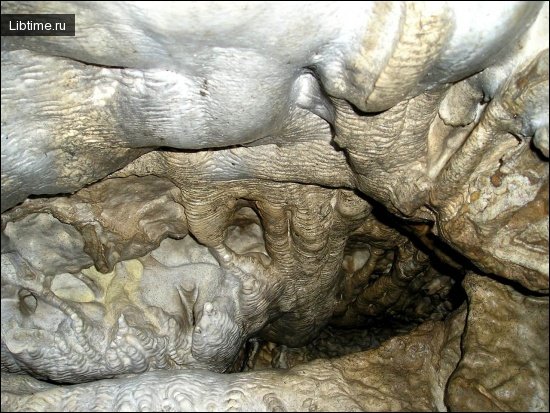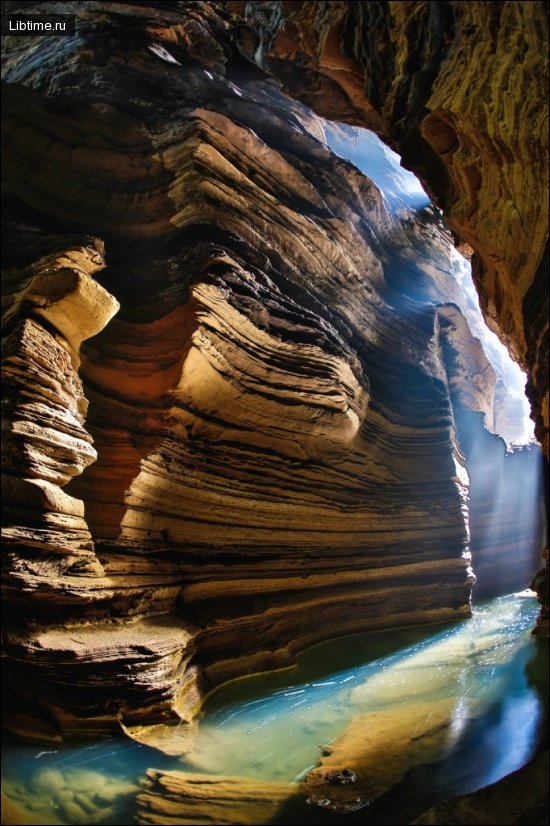The ice of the caves
The ice of caves is very interesting. Among sublimation formations, ice crystals formed as a result of the interaction of relatively warm air with cooled objects are of the greatest interest.
They have the most diverse shape, which is determined by the temperature regime, humidity, direction and speed of air flows (Dorofeev, 1969). 
The most beautiful are pyramidal crystals, usually represented by clusters of spiral pyramids up to 15 cm across. Occasionally, relatively regular closed hexagonal pyramids with the top facing the ceiling appear on cave vaults.
Also beautiful are fern-like crystals that form in severe frosts and look like thin (0.025 mm) plates up to 5 cm long, hanging in a dense fringe from the ceiling of caves. These crystals are ephemeral; at a slight increase in temperature they are destroyed.
The crystals often form sparkling garlands, openwork lace and transparent curtains. Ice crystals are transparent and very fragile. When touched, they shatter into small pieces that slowly fall to the floor of the cave.
Ice crystals usually appear in the spring and last for several months. Only in some caves, especially those located in the permafrost region, there are perennial crystals.
The chemical composition of ice crystals depends on the composition of rocks. According to E.P. Dorofeev (1969), the mineralization of annual sublimation ice crystals of the Kungur cave is 56-90 mg/l, and that of perennial ice crystals is 170 mg/l. Infiltration forms include ice stalactites, stalagmites and stalagnates of hydrogenic origin.
They are formed as a result of the transition of water into the solid phase. These forms reach 10 meters in height and 3 meters in diameter. Their age varies from 2-3 months to several years. In the Kungur cave, for example, there is an ice stalagmite, the age of which exceeds 100 years.
Annual forms are transparent, and perennial forms due to impurities have a milky white color with a bluish or greenish tinge. 
As shown by the studies of M. P. Golovkov (1939), annual stalactites in the Kungurskaya Cave are optically uniaxial single crystals, while perennial stalactites consist of many, layer by layer, elongated, partially faceted crystals oriented with optical axes parallel to the length of the stalactite.
By chemical composition, ice of stalactites, stalagmites and stalagnates can be fresh with the amount of soluble substances up to 0.1% (1 g/l) or brackish, which contains soluble substances from 0.1 to 1%.
Fresh ice is usually found in carbonate caves and brackish ice in sulfate caves. On the walls and vaults in the cold part of some caves there is a crust of icing, which is formed, on the one hand, due to the freezing of water flowing down the cracks, and on the other hand - due to sublimation of water vapor. Its thickness varies usually from a fraction of a millimeter to 10-15 cm. Ice is transparent, sometimes milky-white, fresh (soluble substances less than 1 g/l) or brackish.
The age of the ice crust can be very different, in some cases it is perennial. Cover ice is often developed on the floor of grottoes and passages of ice caves. It is of hydrogenic or heterogeneous origin. The thickness of cover ice varies from several centimeters to several meters. Perennial, often layered ice prevails. Firn occurs in areas of snow accumulation.
The chemical composition of the cover ice depends on the composition of karst rocks. Fresh and brackish ice are distinguished. The latter in gypsum caves is characterized by calcium-sulfate composition. Mineralization of cave ice reaches 0.21%. Of particular interest are ice crystals formed on the cave floor during the solidification of infiltration water.
They have the form of conjoined needles with plates growing from below. Congelation ice is represented by ice of underground lakes and rivers. Lake ice is formed on the surface of underground lakes during the cold season or throughout the year. The area of lake ice depends on the size of the lake.
In some cases it reaches 500 m2, and the ice thickness is 0.15 m (Geographical Society lake in the Abogydzha cave, on the May River). Ice on underground streams has predominantly local distribution. The area of river ice and its thickness are usually small. The origin of lake and river ice is hydrogenic.
When underground water bodies freeze, crystals in the form of six-pointed stars, 1 mm thick and up to 10 cm across, are sometimes formed. Cave ice contains various trace elements. The spectral analysis of cave ice taken from the icing crust in the Brilliant Grotto of Kungurskaya Cave showed that strontium predominates among trace elements, accounting for more than 0.1%.
The content of manganese, titanium, copper, aluminum and iron does not exceed 0.001%. According to the conditions of cave cold, snow and ice accumulation, N. A. Gvozdetsky (1972) distinguishes seven types of karst ice caves in the Russia and Ukraine:
- karst wells and chasms with snow and ice, the ice in which is formed from snow falling in the cold season through the mouth opening;
- bag-shaped cold caves, ice in which can be formed by freezing of water coming from cracks;
- through, or blow-through, cold caves with the direction of air draft changing in warm and cold half-years, with hydrogenic ice and atmogenic, or sublimation, ice crystals;
- through-horizontal ice caves with a window in the ceiling through which snow that turns to ice enters;
- through, or blow-through, caves - areas of permafrost, where cave ice represents its special form;
- well-shaped cavities - areas of permafrost;
- bag-shaped cavities - permafrost areas.


